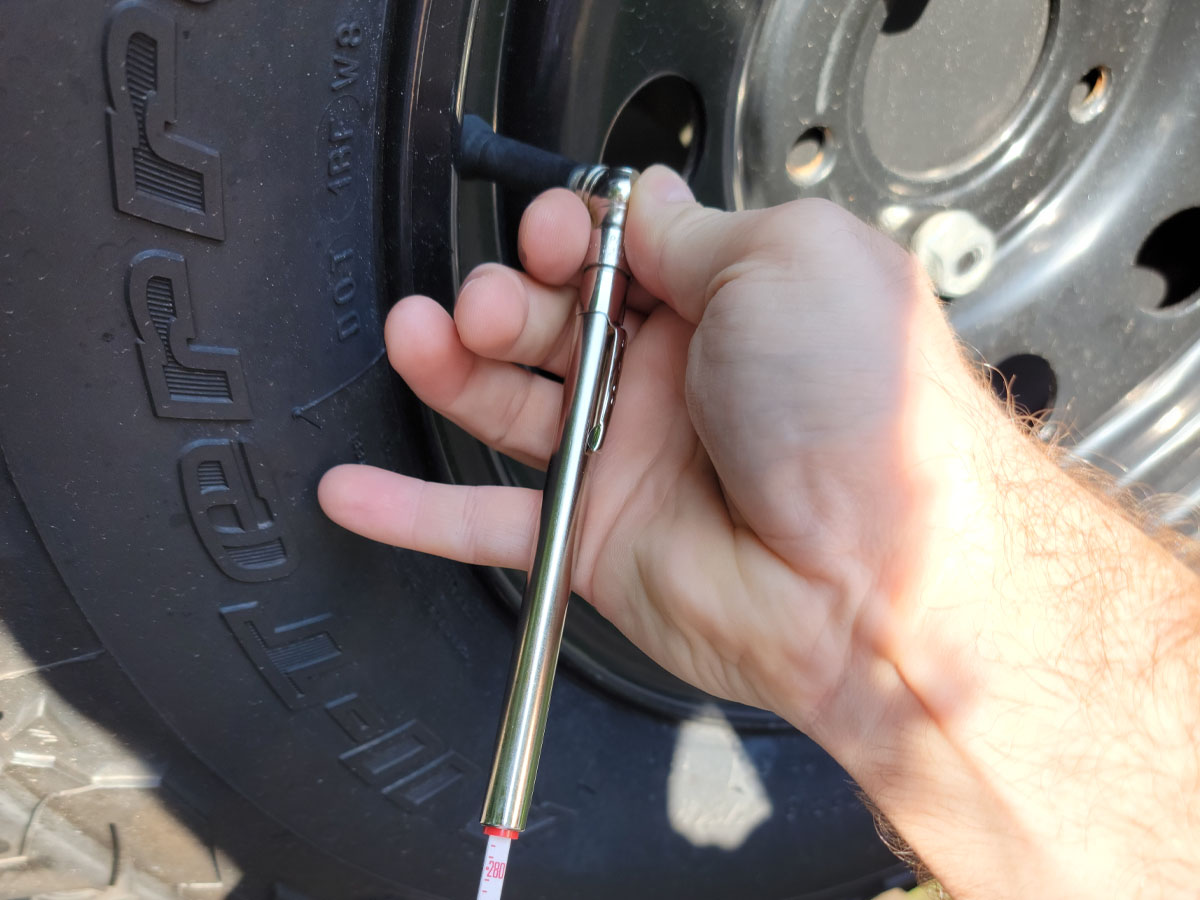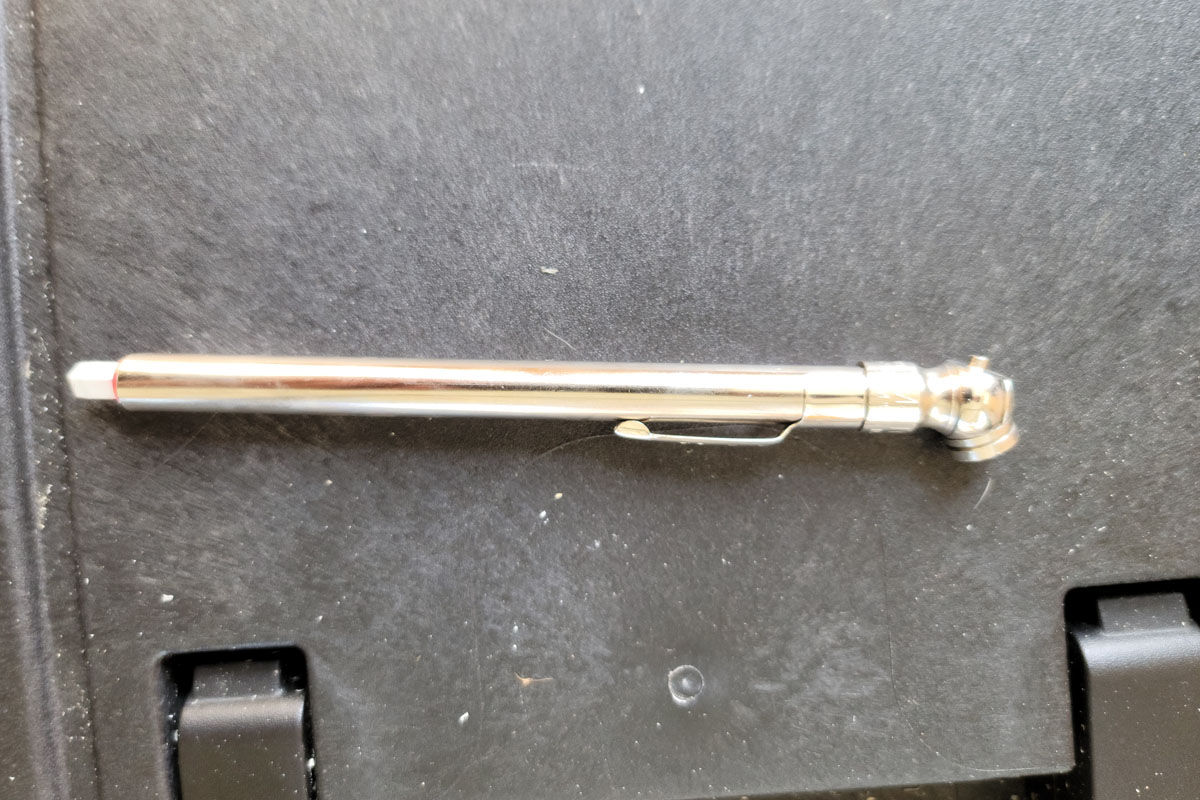

We may earn revenue from the products available on this page and participate in affiliate programs. Learn More ›
New technology is great, as it can make life simpler, more convenient, and fast-track our daily lives. But there is such a thing as overcomplicating a situation with too much tech or too many features. Sometimes, less is more. Your vehicle’s tire pressure may be one of those scenarios, and the solution might be the Milton tire gauge.
When it comes to tire pressure gauges, accuracy is certainly important. But is pinpoint accuracy critical? Do you really need to know the pressure of a lawn tractor’s tires to plus or minus 1 percent? Does a tenth of a psi really matter on an SUV that weighs 6,000 pounds? Does a backlit digital display somehow provide a different reading? Chances are that the answer to all of those questions is “no,” and a simple stick gauge will do the trick.
So, to offer a convenient, simple solution for your tire pressure-checking needs, I reviewed the simple and easy Milton stick-style tire pressure gauge. Keep reading to find out how I feel about this gauge and how well it works.
Milton (S-921) Single Chuck Tire Pressure Gauge: At a Glance

Rating: 8/10
PROS
- Very easy to use
- Built with quality materials for durability
- An affordable option for tire pressure monitoring
CONS
- No frills to speak of
- Needs to stay clean to work properly
Get the Milton Tire Gauge on Amazon for $6.99.
What Is the Milton Tire Gauge?
If you’re new to the old way of doing things, the Milton tire pressure gauge is a simple device used to measure the amount of air pressure inside a tire. It slips onto the uncapped fill valve of a tire, presses the valve open, and then pushes a stick out of the bottom of the device. This stick has graduated markings on it. The farther it sticks out, the more pressure there is in the tire. Aptly named, this is a stick-style gauge.
Milton isn’t the only company that makes stick-style gauges. They’re incredibly common, and they often come as bonus tools in mechanics tool kits and tire repair kits, and can often be found next to the registers in small bins in auto parts stores everywhere.
As far as what makes a stick-style gauge better than a typical digital model, or even an analog model, is that these gauges (including the Milton tire gauge) fit in a shirt pocket. Also, since the air from the tire pushes the stick out to its reading position, they don’t require batteries or charging.
Milton’s version of the stick-style pressure gauge features an operational range of 0 to 50 psi (or 40 to 350 kPa). The body of this tire gauge is durable plated brass, and the pressure indicator stick is nylon with clearly marked increments and numerals.
How Easy Is the Milton Tire Gauge to Put Together?
There’s really nothing to figure out about the Milton tire gauge. Again, it’s simplicity at its best.
The toughest thing about setting up the Milton tire gauge is getting it out of its package. Once removed, it’s fully assembled and ready for use. There aren’t any accessories to install, attach, or fumble around with. It also doesn’t need any oil or adjustments, so it’s ready to go straight out of the package.
There is one aspect of the Milton tire gauge that you can adjust, remove, or dial in, and it’s the pocket clip. This piece of spring steel can slide up, down, or around the shaft of the gauge, allowing the user to place it where it’s most comfortable. Also, if you’d prefer no pocket clip at all, that’s a possibility: Just slide it off the end of the gauge for a sleeker feel in hand.

Is the Milton Tire Gauge Easy to Use?
Just as the Milton tire gauge is easy to set up, it’s equally easy to use. The simple design has just two purposes: check tire pressure and relieve tire pressure, both of which it does easily.
To check the tire pressure, all the user has to do is remove the cap from the tire stem and press the chuck directly onto the fill valve. The user is likely to feel a little “bounce,” which is the valve stem inside the valve depressing. At that point, the air from inside the tire will flow into the Milton tire valve and push the stick to its corresponding position. It’s that easy.
Should the user find that the pressure is too high (on a hot day, for example), they can use the Milton tire gauge to lower the pressure as well. On the back side of the head opposite the chuck, there is a small knob in the middle of a flat surface. Pressing that knob down on the tire valve allows air to escape, lowering the pressure inside the tire. There’s nothing to it.
Note: The one downside to this gauge, which applies to all stick-style gauges, is that it must stay clean. Any grease, dirt, mud, gunk, or water that makes its way into the body can cause the stick to, well, stick. A stuck stick isn’t going to be very accurate.
Is the Milton Tire Pressure Gauge Good Quality?
I’ve been working on cars for the majority of my life, and more than once, I’ve given a stick-style tire gauge the heave-ho for being low quality. They typically dent easily, get stuck, and some even snap where the head and shaft connect. More often than not, they’re not great quality.
The Milton tire gauge is something very different. It’s much heavier than a typical stick gauge, and the quality appears to be way ahead of the competition. It also doesn’t rattle like a lesser model, which makes it less annoying to use and a bit more confidence-inspiring.
On the other hand, the pocket clip is the same low-quality metal I’ve come to expect from stick-style gauges. With a few stiff bends, it’s sure to break at some point. This is par for the course, but it shouldn’t be a deal-breaker unless you’re a mechanic and need to keep a tire gauge in your shirt pocket at all times.

Is the Milton Tire Pressure Gauge Worth It?
When deciding whether or not the Milton tire pressure gauge is worth it, there are just a few things to consider: quality and price.
With firsthand knowledge of other stick-style gauges, I’m confident in saying that Milton’s version is better quality. The entire body is brass, which means it can take a few drops or mishaps before damage claims its usefulness.
It’s also pretty tough to find another quality mechanical tool that will provide consistent readings in its price point (just $6.99 on Amazon). There are digital versions, but their accuracy is suspect at best, and they require a battery. Analog models are comparable, but they rarely fit in a shirt pocket. For the price, the Milton tire gauge stands on its own.
So, is the Milton tire gauge worth it? While the answer might be relative, it’s most likely a “yes.”
Should You Buy the Milton Tire Gauge?
The Milton tire gauge might not be for everyone. After all, most vehicles today have tire pressure monitoring systems. But there are a few types of people who could benefit from one of these models:
- Anyone who drives an older vehicle should keep a tire pressure gauge in their car. If you’re like me and choose to drive a vintage SUV, storage can be at a premium. I can fit the Milton tire gauge almost anywhere in my truck, including the glove box, doors, and center console. For folks in similar situations, this is a great tool to keep on hand.
- If you’re a mechanic or a tire technician, you have access to a wide variety of pressure gauges. But, if you’d like to keep a mechanical backup in your pocket, the Milton’s a great candidate. It’s high quality and durable.
- Vehicle maintenance DIYers can benefit from adding this tool to their kit. In just a few seconds, they can grab this gauge, check their tire pressure, and move on. It’s also a helpful tool for checking the accuracy of built-in gauges on their air compressors, which have a tendency to fail over time.
Get the Milton Tire Gauge on Amazon for $6.99.
